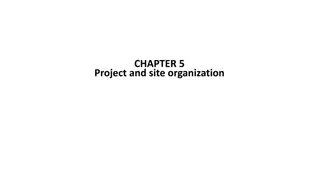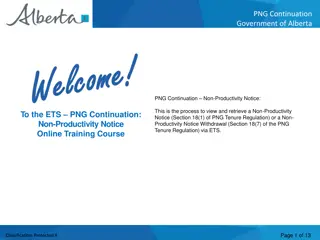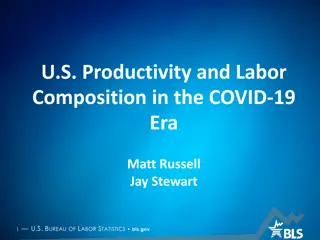
Healthcare Productivity and Efficiency Measures
Productivity and efficiency in healthcare are crucial for delivering quality services while managing costs effectively. This report discusses the concept of productivity, different measures used to assess productivity in healthcare settings, trends in productivity over the years, and future steps to monitor and improve productivity. By focusing on factors like workforce productivity, cost per weighted activity unit, and overall efficiency, healthcare organizations can strive towards achieving better outcomes and financial sustainability.
Download Presentation

Please find below an Image/Link to download the presentation.
The content on the website is provided AS IS for your information and personal use only. It may not be sold, licensed, or shared on other websites without obtaining consent from the author. If you encounter any issues during the download, it is possible that the publisher has removed the file from their server.
You are allowed to download the files provided on this website for personal or commercial use, subject to the condition that they are used lawfully. All files are the property of their respective owners.
The content on the website is provided AS IS for your information and personal use only. It may not be sold, licensed, or shared on other websites without obtaining consent from the author.
E N D
Presentation Transcript
To: For meeting on: Agenda item: Report by: Report on: The Board 28 July 2016 17 Toby Auterson, Senior Economist Productivity 1
What is productivity? Productivity is the value added to inputs used (staff, buildings, drugs, etc) through the process of delivering healthcare. Efficiency includes both productivity and economy, by which inputs are obtained as cheaply as possible. The quality of healthcare delivered allocative efficiency, above is (largely) not captured in the efficiency and productivity metrics we use. 2
Productivity and efficiency measures Source/name Description Source note Latest data CHE(University of York)/total factor and workforce productivity *Our preferred productivity indicator*. Based on a mix of HES, Reference Costs (RCs), ESR and other sources. England; all NHS; cost- weighted. 2013/14 Economics team/trend efficiency Based on RCs. Similar to total factor productivity, but filters out other trust-level characteristics (eg disease prevalence). Used in determining the efficiency factor for the tariff. England; acute trusts; cost- weighted. 2014/15 DH/workforce productivity Based on MAR (a narrow activity metric) and ESR staff data. May not be a good indicator of wider productivity and efficiency, but up-to-date. England; all trusts; cost- weighted. 2015/16 Providers/cost improvement plans (CIPs) England; all trusts. 2015/16 Trusts own plans to reduce costs against their projections. Savings can be recurrent or non- recurrent; through activity reduction or lower input prices; and vary with local accounting adjustments. CIPs are not directly comparable to efficiency and productivity measures (which exclude effects on input costs of changes in activity). But recurrent CIPs, excluding savings through activity reduction and accounting adjustments, are similar. Workforce productivity is reported in a more up-to-date way, but may not be a good indicator for wider productivity and efficiency (could be offset by greater use of non-labour inputs). 3
Productivity trends and the SR ask Rapid acceleration in activity and funding growth, from 2000/01 to 2005/06 Francis Report, Feb 2013 6% To achieve provider balance in 2016/17, with underlying deficit of 3.2 billion in 2015/16 Pay restraint, from 2011/12 5% 4% 3% To achieve provider balance in 2016/17, with Spending Review assumption of 1.8 billion deficit in 2015/16 Annual growth 2% 1% 0% -1% -2% Workforce productivity (DH) Total productivity (CHE) Workforce productivity (CHE) -3% -4% 1998/99 2001/2 2004/5 2007/8 2010/11 2013/14 2016/17 CHE data show both total and workforce productivity running at c2% in 2013/14; the latest Economics Team estimate of trend efficiency is 1% (based on RCs for 2008/09 to 2014/15). DH workforce productivity growth for 2015/16 is <0%. Given their historic relationship (TFP growth is generally < workforce productivity growth), total productivity growth is likely to be even lower. 4
Economics Team next steps We are developing a cost per WAU (weighted activity unit) metric, which will allow in-year monitoring of productivity. We have developed a system economics dashboard, which will allow interrogation of monthly activity, workforce and workforce productivity data, at trust, point of delivery and staff group level. This product is currently in testing. The question of how to achieve the SR requirement for provider productivity equivalent to c 9 billion savings (or c9% efficiency improvement) by 2021 is being addressed by: the Carter report, which identifies c9% efficiencies for non-specialist acute trusts; and our own work, which identifies c10% efficiencies across all trusts, through wider adoption of a range of proven, substantial savings actions:Example savings actions: Expediting discharge, improving care flow, reducing DNAs, improving ambulatory pathways Patient pathway 2.6% Optimised use of clinical workforce Skill mix, sickness and turnover, mobile working, digital technology, paperwork, inter-disciplinary teams 3.8% Procurement, pharmacy and medicines optimisation Hospital medicines (bio-similars), procurement collaboration 1.0% Diagnostics and business as usual functions Better use of estates, sharing back office and diagnostic functions 1.4% Improving elective and urgent care, reducing harms, reducing adverse medicines events Care best practice 0.8% Total opportunity 9.7% 5






















